1998 HONDA ODYSSEY service
[x] Cancel search: servicePage 241 of 272
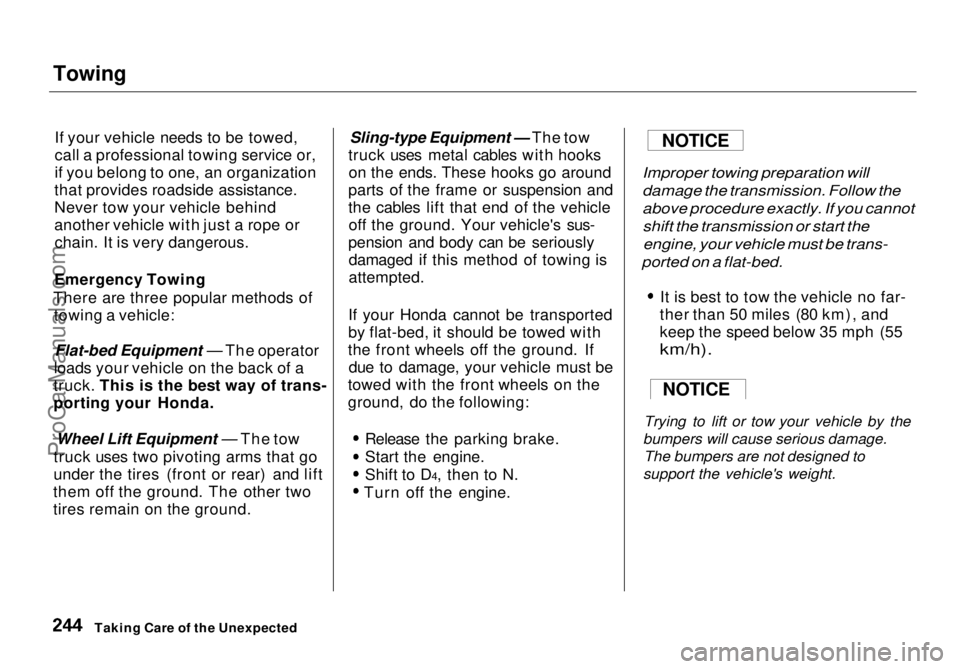
Towing
If your vehicle needs to be towed,
call a professional towing service or,
if you belong to one, an organization
that provides roadside assistance.
Never tow your vehicle behind
another vehicle with just a rope or chain. It is very dangerous.
Emergency Towing
There are three popular methods of towing a vehicle:
Flat-bed Equipment — The operator
loads your vehicle on the back of a
truck. This is the best way of trans-
porting your Honda.
Wheel Lift Equipment — The tow
truck uses two pivoting arms that go
under the tires (front or rear) and lift
them off the ground. The other two
tires remain on the ground.
Sling-type Equipment — The tow
truck uses metal cables with hooks on the ends. These hooks go around
parts of the frame or suspension and
the cables lift that end of the vehicle off the ground. Your vehicle's sus-
pension and body can be seriously damaged if this method of towing is
attempted.
If your Honda cannot be transported
by flat-bed, it should be towed with
the front wheels off the ground. If due to damage, your vehicle must be
towed with the front wheels on the
ground, do the following:
Release the parking brake.
Start the engine.
Shift to D4, then to N.
Turn off
the engine.
Improper towing preparation will
damage the transmission. Follow the
above procedure exactly. If you cannot
shift the transmission or start the
engine, your vehicle must be trans-
ported on a flat-bed.
It is best to tow the vehicle no far-
ther than 50 miles (80 km), and
keep the speed below 35 mph (55
km/h).
Trying to lift or tow your vehicle by the
bumpers will cause serious damage. The bumpers are not designed to
support the vehicle's weight.
Taking Care of the Unexpected
NOTICE
NOTICEProCarManuals.comMain Menu Table of Contents s t
Page 248 of 272
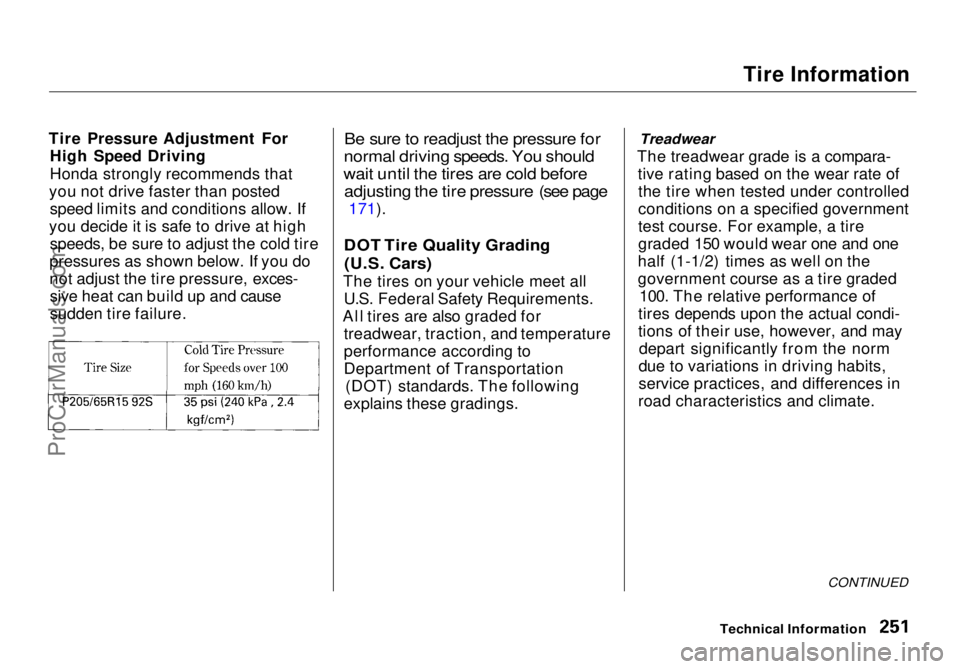
Tire Information
Tire Pressure Adjustment For High Speed Driving
Honda strongly recommends that
you not drive faster than posted speed limits and conditions allow. If
you decide it is safe to drive at high speeds, be sure to adjust the cold tire
pressures as shown below. If you do
not adjust the tire pressure, exces- sive heat can build up and cause
sudden tire failure.
Be sure to readjust the pressure for
normal driving speeds. You should
wait until the tires are cold before adjusting the tire pressure (see page
171).
DOT Tire Quality Grading (U.S. Cars)
The tires on your vehicle meet all U.S. Federal Safety Requirements.
All tires are also graded for treadwear, traction, and temperature
performance according to
Department of Transportation (DOT) standards. The following
explains these gradings.
Treadwear
The treadwear grade is a compara- tive rating based on the wear rate ofthe tire when tested under controlled
conditions on a specified government
test course. For example, a tire
graded 150 would wear one and one
half (1-1/2) times as well on the
government course as a tire graded 100. The relative performance of
tires depends upon the actual condi-
tions of their use, however, and may depart significantly from the norm
due to variations in driving habits,
service practices, and differences in
road characteristics and climate.
CONTINUED
Technical InformationProCarManuals.comMain Menu Table of Contents s t
Page 250 of 272

Oxygenated Fuels
Some conventional gasolines are
being blended with alcohol or an
ether compound. These gasolines
are collectively referred to as
oxygenated fuels. To meet clean air
standards, some areas of the United
States and Canada use oxygenated
fuels to help reduce emissions.
If you use an oxygenated fuel, be
sure it is unleaded and meets the
minimum octane rating requirement.
Before using an oxygenated fuel, try
to confirm the fuel's contents. Some
states/provinces require this
information to be posted on the
pump.
The following are the EPA-approved
percentages of oxygenates:
ETHANOL (ethyl or grain alcohol)
You may use gasoline containing up to 10 percent ethanol by volume. Gasoline containing ethanol may be
marketed under the name "Gasohol."
MTBE (Methyl Tertiary Butyl Ether)
You may use gasoline containing up to 15 percent MTBE by volume.
METHANOL (methyl or wood
alcohol)
You may use gasoline containing up to 5 percent methanol by volume as
long as it also contains cosolventsand corrosion inhibitors to protect
the fuel system. Gasoline containing
more than 5 percent methanol by
volume may cause starting and/or
performance problems. It may also damage metal, rubber and plastic
parts of your fuel system. If you notice any undesirable
operating symptoms, try another
service station or switch to another
brand of gasoline.
Fuel system damage or performance
problems resulting from the use of an oxygenated fuel containing more
than the percentages of oxygenates
given above are not covered under
warranty.
Technical InformationProCarManuals.comMain Menu Table of Contents s t
Page 256 of 272
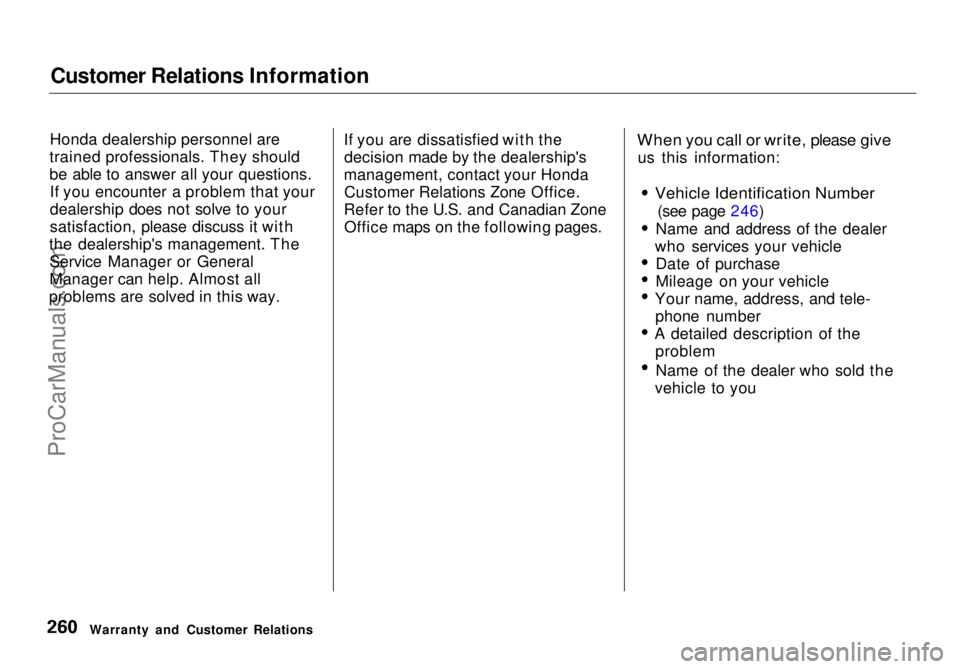
Customer Relations Information
Honda dealership personnel are
trained professionals. They should
be able to answer all your questions. If you encounter a problem that your
dealership does not solve to your
satisfaction, please discuss it with
the dealership's management. The Service Manager or General
Manager can help. Almost all
problems are solved in this way. If you are dissatisfied with the
decision made by the dealership's
management, contact your Honda Customer Relations Zone Office.
Refer to the U.S. and Canadian Zone Office maps on the following pages.
When you call or write, please give
us this information:
Vehicle Identification Number
(see page 246)
Name and address of the dealer
who services your vehicle Date of purchase
Mileage on your vehicle
Your name, address, and tele- phone number
A detailed description of the problem
Name of the dealer who sold the
vehicle to you
Warranty and Customer RelationsProCarManuals.comMain Menu Table of Contents s t
Page 262 of 272
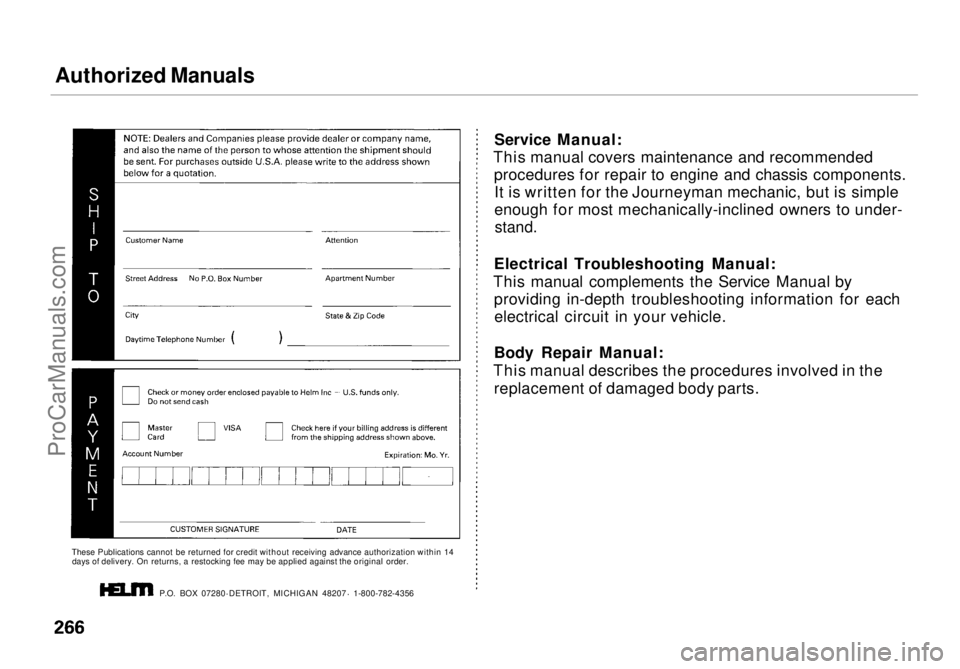
Authorized Manuals
These Publications cannot be returned for credit without receiving advance authorization within 14days of delivery. On returns, a restocking fee may be applied against the original order. P.O. BOX 07280 DETROIT, MICHIGAN 48207 1-800-782-4356 Service Manual:
This manual covers maintenance and recommended procedures for repair to engine and chassis components.It is written for the Journeyman mechanic, but is simple
enough for most mechanically-inclined owners to under-
stand.
Electrical Troubleshooting Manual:
This manual complements the Service Manual by providing in-depth troubleshooting information for eachelectrical circuit in your vehicle.
Body Repair Manual:
This manual describes the procedures involved in the replacement of damaged body parts.ProCarManuals.comMain Menu Table of Contents s t
Page 269 of 272

Index
Safety Belts......................................... 6
Safety Defects, Reporting* .......... 264
Safety Features.................................. 5
Air bags........................................... 7Door Locks..................................... 9
Head Restraints............................. 8
Seat Belts........................................ 6
Seats & Seat-Backs........................ 8
Safety Labels, Location of.............. 48
Safety Messages................................ ii
Seat Belt, Additional Information ..41 Lap Belt......................................... 42
Lap/Shoulder Belt....................... 41
Seat Belt Maintenance................ 42
Seat Belt System Components... 41
Seat Belts............................................ 6
Cleaning...................................... 217
Maintenance................................. 42
Reminder Light and Beeper....... 52
System Components.................... 41
Tether Attachment Points.......... 38 Use During Pregnancy................ 17
Seats.................................................. 74
Adjustments................................. 74
Driver's Seat Power
Height Adjustment.................. 75
Folding the Second Seats........... 78
Folding the Third Seats.............. 80
Head Restraints........................... 76
Passenger Seating....................... 74
Reclining the Second Seat.......... 79 Removing the Second Seats....... 78
Third Seat Access........................ 77
Serial Number................................ 246
Service Intervals*.......................... 164
Service Manual.............................. 265 Service Station Procedures .......... 129
Setting the Clock............................. 86
Shifting the Automatic Transmission.............................. 142
Shift Lever Position Indicator...... 142
Shift Lever Positions..................... 142
Side Marker Lights, Bulb
Replacement in.......................... 207
Signaling Turns................................ 59
Snow Tires...................................... 201
Solvent-type Cleaners.................... 214
Sound System................................. 103
Spare Tire
Inflating....................................... 222
Specifications............................. 249
Spark Plugs, Replacing................. 187
Specifications Charts..................... 248
Speed Control................................... 64
Speedometer.................................... 55
SRS, Additional Information........... 42
Additional Safety Precautions.... 46How Your Airbags Work............ 44
How Your SRS Indicator
Works........................................ 46
SRS Components......................... 44
SRS Service................................... 46
SRS Indicator.............................. 46, 52
START (Ignition Key Position)..... 70
Starting the Engine........................ 141 In Cold Weather at High
Altitude................................... 141
With a Dead Battery................. 230
Steam Coming from Engine......... 232
Steering Wheel
Adjustment................................... 62
Anti-theft Column Lock.............. 70
Stereo Sound System.................... 103
CONTINUEDProCarManuals.comMain Menu s t
Page 272 of 272
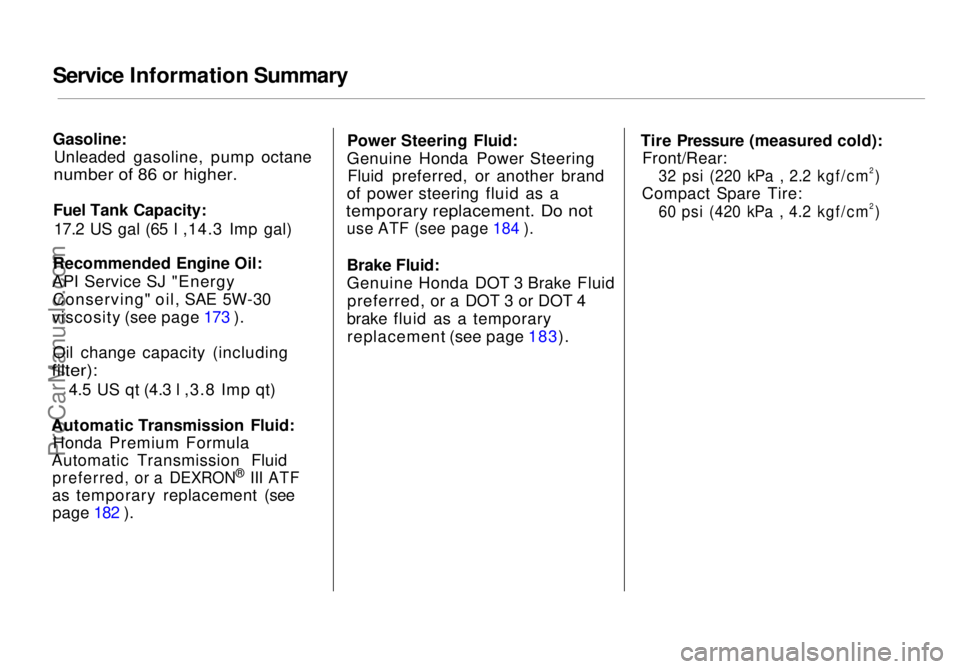
Service Information Summary
Gasoline:
Unleaded gasoline, pump octane
number of 86 or higher.
Fuel Tank Capacity: 17.2 US gal (65 l ,14.3 Imp gal)
Recommended Engine Oil:
API Service SJ "Energy Conserving" oil, SAE 5W-30
viscosity (see page 173 ).
Oil change capacity (including
filter):
4.5 US qt (4.3 l ,3.8 Imp qt)
Automatic Transmission Fluid: Honda Premium Formula
Automatic Transmission Fluid
preferred, or a DEXRON ®
III ATF
as temporary replacement (see page 182 ). Power Steering Fluid:
Genuine Honda Power Steering Fluid preferred, or another brand
of power steering fluid as a
temporary replacement. Do not
use ATF (see page 184 ).
Brake Fluid:
Genuine Honda DOT 3 Brake Fluid
preferred, or a DOT 3 or DOT 4
brake fluid as a temporary replacement (see page 183). Tire Pressure (measured cold):
Front/Rear:
32 psi (220 kPa , 2.2 kgf/cm2)
Compact Spare Tire:
60 psi (420 kPa , 4.2 kgf/cm2)ProCarManuals.comMain Menu s t